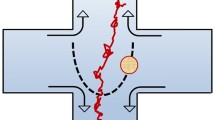Abstract
Entropy production along a single stochastic trajectory of a biomolecule is discussed for two different sources of non-equilibrium. For a molecule manipulated mechanically by an AFM or an optical tweezer, entropy production (or annihilation) occurs in the molecular conformation proper or in the surrounding medium. Within a Langevin dynamics, a unique identification of these two contributions is possible. The total entropy change obeys an integral fluctuation theorem and a class of further exact relations, which we prove for arbitrarily coupled slow degrees of freedom including hydrodynamic interactions. These theoretical results can therefore also be applied to driven colloidal systems. For transitions between different internal conformations of a biomolecule involving unbalanced chemical reactions, we provide a thermodynamically consistent formulation and identify again the two sources of entropy production, which obey similar exact relations. We clarify the particular role degenerate states have in such a description.
Similar content being viewed by others
References
C. Bustamante, J. Liphardt and F. Ritort, Phys. Today 58:43 (2005).
F. Ritort, Sém. Poincaré 2:63 (2003).
K. Sekimoto, Prog. Theor. Phys. Supp. 130: 17 (1998).
C. Jarzynski, Phys. Rev. Lett. 78:2690 (1997).
C. Jarzynski, Phys. Rev. E 56: 5018 (1997).
G. E. Crooks, Phys. Rev. E 60: 2721 (1999).
G. E. Crooks, Phys. Rev. E 61: 2361 (2000).
G. Hummer and A. Szabo, Proc. Natl. Acad. Sci. U.S.A. 98:3658 (2001).
J. Liphardt, S. Dumont, S. B. Smith, I. Tinoco Jr. and C. Bustamante, Science 296:1832 (2002).
O. Braun, A. Hanke and U. Seifert, Phys. Rev. Lett. 93: 158105 (2004).
S. Park and K. Schulten, J. Chem. Phys. 120:5946 (2004).
D. Collin, F. Ritort, C. Jarzynski, S. Smith, I. Tinoco and C. Bustamante, Nature 437:231 (2005).
T. Speck and U. Seifert, Eur. Phys. J. B 43:543 (2005).
T. Speck and U. Seifert, Phys. Rev. E 70:066112 (2004).
A. Imparato and L.Peliti, Europhys. Lett. 69:643 (2005).
A. Imparato and L. Peliti, Europhys. Lett. 70:740 (2005).
U. Seifert, Phys. Rev. Lett. 95:040602 (2005).
G. Oster, A. Perelson and A. Katchalsky, Nature 234: 393 (1971).
J. Schnakenberg, Rev. Mod. Phys. 48:571 (1976).
T. L. Hill, Free Energy Transduction and Biochemical Cycle Kinetics, 2nd ed. (Dover, 1989).
G. Nicolis and I. Prigogine, Self-Organization in Nonequilibrium Systems:From Dissipative Structures to Order through Fluctuations (Wiley, 1977).
P. Gaspard, J. Chem. Phys. 120:8898 (2004).
D. Andrieux and P. Gaspard, J. Chem. Phys. 121:6167 (2004).
H.Qian and D. A. Beard, Biophys. Chem. 114:213 (2005).
H. Qian, J. Phys.: Condens. Matter 17:S3783 (2005).
T. Shibata, cond-mat/0012404 (2000).
U. Seifert, Europhys. Lett. 70:36, (2005).
P. Schwille, Cell Biochem. Biophys. 34:383 (2001).
X. S. Xie, J. Chem. Phys. 117:11024 (2002).
H. Qian, Biophys. Chem. 67:263 (1997).
F. Jülicher, A. Adjari and J. Prost, Rev. Mod. Phys. 69:1269 (1997).
M. E. Fisher and A. B. Kolomeisky, Proc. Natl. Acad. Sci. U.S.A. 96:6597 (1999).
R. Lipowsky, Phys. Rev. Lett. 85:4401 (2000).
H. Qian, Phys. Rev. E 64:022101 (2001).
P. Reimann, Phys. Rep. 361:57 (2002).
C. Maes and M. H. van Wieren, J. Stat. Phys. 112:329 (2003).
J. E. Baker, J. Theor. Biol. 228:467 (2004).
T. Hatano and S. Sasa, Phys. Rev. Lett. 86:3463 (2001).
G. M. Wang, E. M. Sevick, E. Mittag, D. J. Searles and D. J. Evans, Phys. Rev. Lett. 89:050601 (2002).
D. M. Carberry, J. C. Reid, G. M. Wang, E. M. Sevick, D. J. Searles and D. J. Evans, Phys. Rev. Lett. 92:140601 (2004).
R. van Zon and E. G. D. Cohen, Phys. Rev. Lett. 91:110601 (2003).
R. van Zon and E. G. D. Cohen, Phys. Rev. E 67:46102 (2003).
E. H. Trepagnier, C. Jarzynski, F. Ritort, G. E. Crooks, C. J. Bustamante and J. Liphardt, Proc. Natl. Acad. Sci. U.S.A. 101:15038 (2004).
V. Blickle, T. Speck, L. Helden, U. Seifert and C. Bechinger, Phys. Rev. Lett. 96:070603 (2006).
M. Doi and S. F. Edwards, The Theory of Polymer Dynamics (Clarendon Press, Oxford, 1986).
C. Jarzynski, J. Stat. Phys. 96:415 (1999).
D. A. McQuarrie, Statistical Mechanics, (University Science Books, Sausalito, 2000).
D. J. Evans and D. J. Searles, Phys. Rev. E 50:1645 (1994).
G. Gallavotti and E. G. D. Cohen, Phys. Rev. Lett. 74:2694 (1995).
J. Kurchan, J. Phys. A: Math. Gen. 31:3719 (1998).
J. L. Lebowitz and H. Spohn, J. Stat. Phys. 95:333 (1999).
C. Maes, Sém. Poincaré 2:29 (2003).
H. Qian, J. Phys. Chem. B 106:2065 (2002).
O. Braun and U. Seifert, Eur. Phys. J. E 18:1 (2005).
T. Schmiedl and U. Seifert, in preparation.
S. Schuler, T. Speck, C. Tietz, J. Wrachtrup and U. Seifert, Phys. Rev. Lett. 94:180602 (2005).
Author information
Authors and Affiliations
Additional information
PACS numbers: 05.40.-a Fluctuation phenomena, random processes, noise, and Brownian motion, 05.70.-a Thermodynamics, 82.39.-k Chemical kinetics in biological systems, 87.15.-v Biomolecules: structure and physical properties
Rights and permissions
About this article
Cite this article
Schmiedl, T., Speck, T. & Seifert, U. Entropy Production for Mechanically or Chemically Driven Biomolecules. J Stat Phys 128, 77–93 (2007). https://doi.org/10.1007/s10955-006-9148-1
Received:
Accepted:
Published:
Issue Date:
DOI: https://doi.org/10.1007/s10955-006-9148-1




